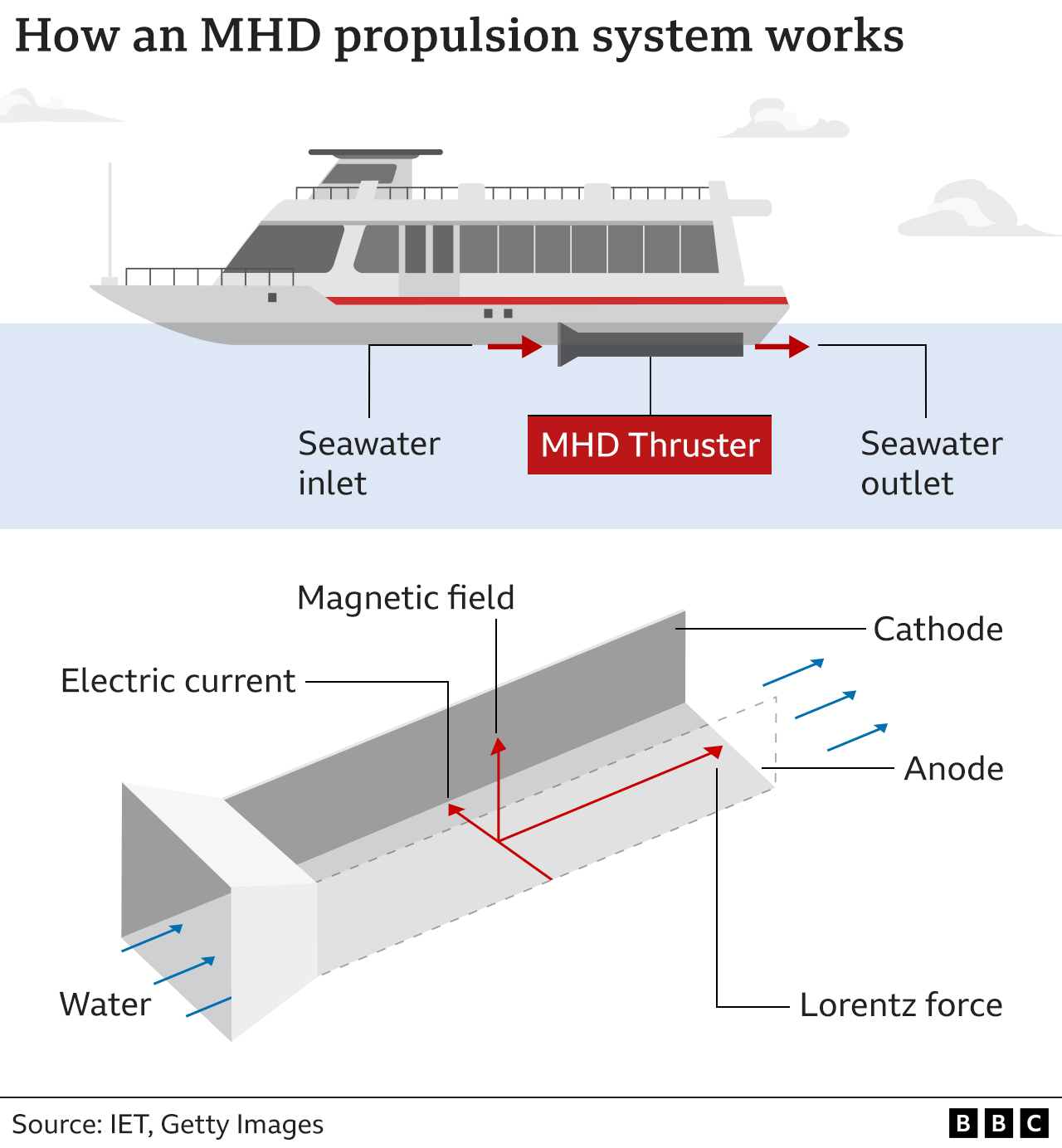
"If you think I'm doing The Hunt for Red October, the answer is yes," says Susan Swithenbank of the US Defense Advanced Research Projects Agency (Darpa).
The 1990 film, starring Sean Connery, featured a Soviet submarine - Red October - which had a near-silent propulsion system, making it very difficult to detect.
Now, 30 years after the movie, Darpa is working on a marine propulsion system similar to the "caterpillar drive" described in the movie.
Called a magnetohydrodynamic (MHD) drive, the system has no moving parts at all - just magnets and an electric current.
It works by generating a magnetic field at a right angle to an electric current. That creates a force - called the Lorentz force - which acts on the sea water and propels the craft along.


Without propellers or a drive shaft churning up the water, a working MHD drive could provide fast and completely silent travel.
Engineers have been working on MHD drives for decades and the original concept dates back to the 1960s.
In 1992, the Japanese Ship and Ocean Foundation built Yamato-1, a 30m-long ship that tested a MHD drive.
However, the drive was so heavy that the Yamato-1 could only manage to plod along at a speed of 6.6 knots. It also used up a lot of energy.
But researchers say the project proved such a drive could work and provided useful data.
"Authentic information on defects and weak points, together with what should be made... when we carry out a Yamato-2 in the future," says Hiromitsu Kitagawa, visiting research fellow at the Ocean Policy Research Institute, of which the Japanese Ship and Ocean Foundation is now part.
The Yamato project showed that much more powerful magnets would be needed, plus more robust electrodes - the parts of the drive which make contact with the water.
According to Ms Swithenbank, the first of these problems may well be easily solvable now, with a new generation of magnets, developed by the nuclear fusion industry.
Fusion is the reaction which powers stars. But to make it happen here on earth often requires extremely powerful magnets to contain swirling clouds of burning hot plasma.
The force generated by these new magnets has been likened to double the pressure at the bottom of the deepest ocean trench.
While more powerful magnets are now available, the second problem, how to protect the electrodes, still needs work.

Metal corrodes when placed in seawater and an electrical current accelerates that process. Some types of magnetic field have the same corrosive effect.
On the Yamato-1 it was found that electrodes were losing around 3% of their mass per year.
Jeffrey Long, a research chemist at the US Naval Research Laboratory (NRL), is a battery specialist, and is expecting to take part in the Darpa programme, along with colleague Zachary Neale.
"If you have ever placed paper clips in a cup of salt water connected to a 9-volt battery, you'd notice the water turns colour because the metal is corroding," he says.
"Essentially, we want electrodes that don't corrode, while still supporting the high electrical current density required for effective operation."
However, improvements in coatings by the fuel cell and battery industries in recent years mean this problem may well now be solvable.
While these are important advances, other problems remain.
Passing a current across seawater breaks the hydrogen-oxygen bond, creating gas bubbles on the electrodes which creates resistance and reduces the efficiency of the MHD.
Potential solutions will have to be tested, including gas-diffusing electrodes created by the fuel cell industry. Other techniques sweep away the bubbles before they build up.
Finally, there's the issue of erosion, with collapsing bubbles creating pitting. "It's like having sandpaper on your electrode," says Ms Swithenbank. Here too, though, work in other industries is showing promise.


If the Darpa team can overcome the problems, the advantages will be enormous.
Without moving parts, MHD drives should need much less maintenance than existing propulsion systems.
"But the real reason everybody's interested in it is that, because there's no moving parts, it's also much quieter," says Ms Swithenbank. "There's no question that for national defence, that's a huge advantage."
A quiet system, without dangerous propellers thrashing around, could be better for wildlife as well.
Work on the project will begin in earnest next spring, with a two-year programme to develop materials - in particular, electrode materials - followed by an 18-month period to design, manufacture and test the drive.
The aim is to produce a prototype MHD drive that could propel a small ship, but that could be scaled up to propel a container ship or a military vessel.
The drive would also have to demonstrate an energy efficiency that could match existing propeller systems.
"Do I see this being used in commercial ships in the next five years? No. But it's absolutely possible in the future," say Ms Swithenbank.
"Idea" - Google News
July 14, 2023 at 06:00AM
https://ift.tt/ejXNCzA
The US military revives an idea for stealthy sea power - bbc.com
"Idea" - Google News
https://ift.tt/d3skmc9
https://ift.tt/mLsDyOR
Bagikan Berita Ini














0 Response to "The US military revives an idea for stealthy sea power - bbc.com"
Post a Comment